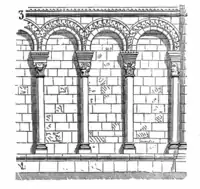
A blind arcade or blank arcade[1] is an arcade (a series of arches) that has no actual openings and that is applied to the surface of a wall as a decorative element: i.e., the arches are not windows or openings but are part of the masonry face. It is designed as an ornamental architectural element and has no load-bearing function.
Similar structures
Whereas a blind arch is usually a single arch or a series of joined arches as a frieze (sometimes called Lombard band), a blind arcade is composed of a series of arches that have well-defined columns in between its arches.
A blind arcade may resemble several blind windows (false/blank windows or sealed-up windows)[1] or blind niches that are side by side.
Examples
Blind arcades are a common decorative features on the facades of Romanesque and Gothic buildings throughout Western Europe, and are also a common feature in Byzantine Orthodox churches in Eastern Europe, and in Armenian churches.
See also


 Córdoba, Spain
Córdoba, Spain Norwich Cathedral, Norfolk, United Kingdom
Norwich Cathedral, Norfolk, United Kingdom
 Canterbury Cathedral, England
Canterbury Cathedral, England

 Linköping Cathedral, Sweden
Linköping Cathedral, Sweden

 Great Mosque of Kairouan (Mosque of Uqba), Tunisia
Great Mosque of Kairouan (Mosque of Uqba), Tunisia Blind arcade on Ardmore Cathedral, Ireland, with sculpted Biblical scenes (12th century)
Blind arcade on Ardmore Cathedral, Ireland, with sculpted Biblical scenes (12th century)
References
- 1 2 Harris, Cyril M. (2013). Illustrated Dictionary of Historic Architecture. Courier. ISBN 978-0-486-13211-2.
Blank arcade. Same as blind arcade. […] blank/blind/false window. 1. A recess […] having the external appearance of a window. 2. A window which has been sealed off but is still visible.
External links
- Dictionary of French Architecture from the 11th to 16th century/Volume 1/Blind Arcade
- The Monasery of Marmashen